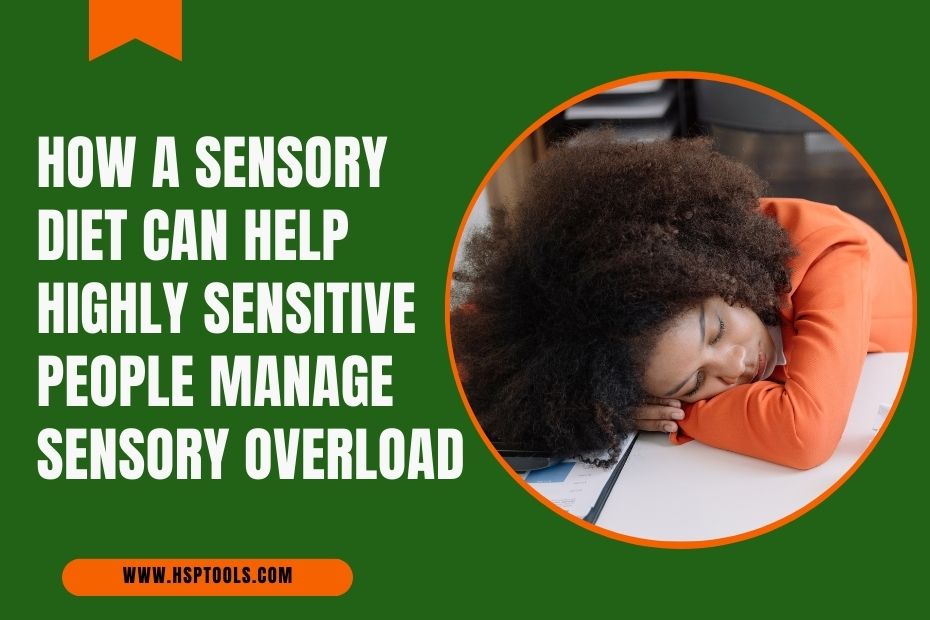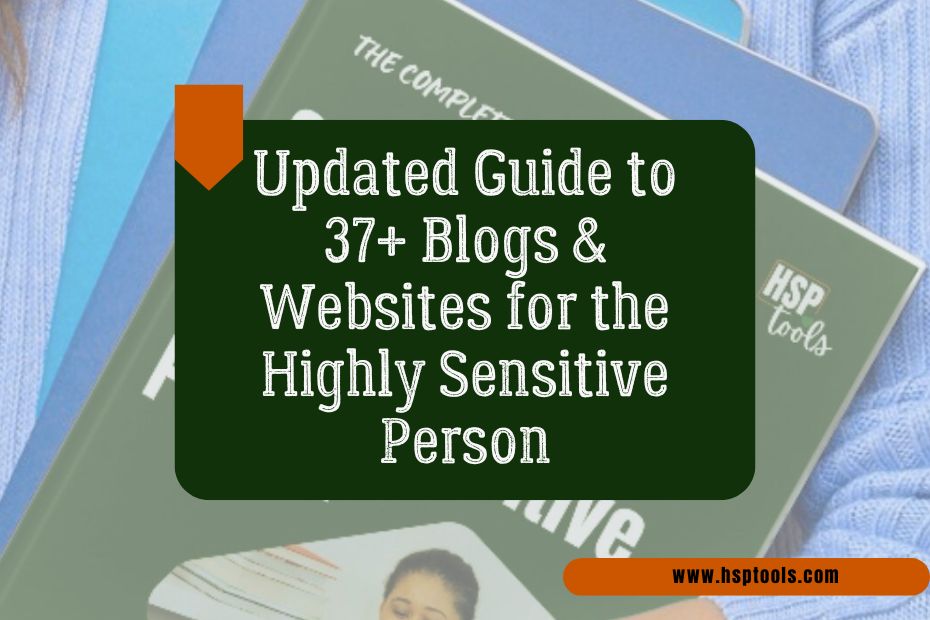How a Sensory Diet Can Help Highly Sensitive People Manage Sensory Overload

As a Highly Sensitive Person (HSP), daily sounds, sights, smells, and textures can profoundly impact your emotional and mental well-being.
While others might brush off a noisy office or a crowded room, these environments may leave you feeling drained, anxious, or overstimulated. This is because HSPs experience sensory input more intensely.
One powerful tool that can help you navigate these challenges is a sensory diet—a structured approach to balancing sensory input throughout your day.
Originally developed in occupational therapy for individuals with sensory processing difficulties, a sensory diet can be an effective strategy for Highly Sensitive People to manage sensory overload and protect their mental health.
This in-depth article explores the concept of a sensory diet, why it’s especially beneficial for HSPs, and how to create a customized sensory diet that works for you.
It will also share research that supports the effectiveness of sensory regulation for HSPs and provide practical, research-backed strategies to help you maintain balance in your daily life.

What Is a Sensory Diet?
A sensory diet is a term originally coined in occupational therapy, specifically for children and adults with sensory processing issues. The concept refers to a carefully designed set of sensory activities and strategies that help regulate the nervous system by providing balanced sensory input.
This “diet” doesn’t refer to food but to the sensory experiences you allow your body to consume throughout the day.
For individuals with sensory processing difficulties, such as those with autism or sensory processing disorder, a sensory diet helps reduce feelings of overstimulation or under-stimulation, allowing for better emotional regulation and focus.
But how does this apply to Highly Sensitive People?
HSPs are characterized by their deep sensitivity to sensory input.
While this sensitivity has benefits, like enhancing creativity, empathy, and emotional depth, it can also become overwhelming when you’re bombarded by too much sensory information.
This is where a sensory diet comes in as an essential tool for self-care.
By curating your sensory experiences and finding the right balance of stimuli, you can manage your sensitivity and avoid emotional or mental burnout.
This practice helps you navigate the demands of everyday life while maintaining your well-being.
Why is a Sensory Diet Important for HSPs
HSPs are more susceptible to sensory overload due to their heightened sensitivity to external and internal stimuli.
When you’re constantly processing vast amounts of sensory data, like the bright lights in a supermarket, the hum of chatter in a crowded café, or even your thoughts and emotions, it can quickly lead to mental fatigue, emotional overwhelm, and anxiety.
A well-planned sensory diet allows you to manage the stimuli you encounter and gives your nervous system the space to recover and reset. Here are four reasons why it’s essential for HSPs:
1. Prevents Sensory Overload
Sensory overload is a common experience for HSPs, and it occurs when the brain receives more sensory input than it can process effectively. This leads to a state of overwhelm, where even small tasks or interactions can feel exhausting or unbearable.
A sensory diet helps by controlling the flow of sensory input and providing intentional breaks from overstimulation.
2. Enhances Emotional Regulation
Not only do HSPs process sensory input deeply but they’re also emotionally reactive to it. When you’re overwhelmed by sensory stimuli, it can be challenging to manage your emotional responses.
A sensory diet introduces calming, grounding experiences that allow your nervous system to stay balanced, improving your ability to regulate emotions, especially in stressful situations.
3. Supports Mental Clarity and Focus
An overactive sensory environment can scatter your attention and make it difficult to focus or think clearly. A sensory diet helps HSPs create environments conducive to focus and mental clarity, by reducing unnecessary stimuli.
Whether it’s quiet time to recharge or using calming sensory inputs, these practices provide relief from constant mental noise.
4. Boosts Overall Well-being
When HSPs don’t actively manage sensory input, it can lead to chronic stress, irritability, fatigue, and even physical symptoms like headaches or digestive issues.
A sensory diet reduces these stressors by maintaining a balance that supports mental and physical well-being. It helps you to feel more grounded, energized, and at peace in your daily life.
Is there Research Supporting Sensory Diets for HSPs?
While the concept of a sensory diet originates from therapies for individuals with sensory processing disorders, applying these principles to Highly Sensitive People is well-supported by scientific research on sensory processing sensitivity.
Below are some key studies and insights that illustrate the importance of sensory regulation for HSPs.
1. Sensory Processing Sensitivity and Overstimulation
Dr. Elaine Aron, a psychologist and leading researcher on HSPs, has conducted extensive studies on how individuals with sensory processing sensitivity (SPS) respond to environmental stimuli.
Her research shows that HSPs have a more reactive nervous system, making them more susceptible to sensory overload.
- Study: Aron, E. N., & Aron, A. (1997). Sensory-processing sensitivity and its relation to introversion and emotionality. Journal of Personality and Social Psychology, 73(2), 345–368.
- Key Insight: HSPs are more likely to become overwhelmed by sensory input, particularly in social and highly stimulating environments, confirming the need for sensory management strategies like a sensory diet.
2. Brain Activity in HSPs and Sensory Regulation
Neuroscientific studies have shown that HSPs exhibit increased activity in the brain regions responsible for emotional regulation and sensory processing.
These areas, including the amygdala and the insula, are hyperactive when HSPs are exposed to emotional or sensory input, which can lead to overwhelm.
- Study: Acevedo, B. P., et al. (2014). The Highly Sensitive Brain: An fMRI study of sensory processing sensitivity and response to others’ emotions. Brain and Behavior, 4(4), 580-594.
- Key Insight: The heightened emotional and sensory reactivity in HSPs underscores the importance of structured sensory input to prevent emotional overload and mental fatigue.
3. Sensory Diets for Emotional and Physical Well-being
The concept of sensory regulation is increasingly linked to improved mental health outcomes, particularly in individuals who are prone to stress and anxiety. Studies on sensory diets highlight how regulating sensory input can reduce symptoms of anxiety and stress, improve focus, and enhance emotional resilience.
- Study: Dunn, W. (2001). The impact of sensory processing abilities on the daily lives of young children and their families: A conceptual model. Infants & Young Children, 14(2), 23–35.
- Key Insight: This research emphasizes the benefits of a sensory diet for children and individuals of all ages who experience heightened environmental sensitivity.
Sensory Diet Practices for HSPs: A Beginner’s Guide
If you’re a Highly Sensitive Person (HSP), managing sensory input is key to maintaining your emotional and mental well-being.
The concept of a sensory diet may be new to you, but it’s simply a way of balancing the amount of stimulation your brain processes.
The goal is to reduce sensory overload and keep your nervous system calm and grounded.
Below are sensory diet strategies specifically designed for HSPs, explained to help you understand why they matter and how you can use them in your daily life.
1. Light Regulation
As an HSP, you may notice that harsh or bright lighting can quickly overwhelm your senses.
Fluorescent lights, for example, can feel jarring and make you anxious or uncomfortable, especially when overstimulated.
- Why it matters: HSPs tend to be more sensitive to lighting conditions. Bright or fluctuating light can trigger a stress response, causing your mind to become overstimulated or fatigued.
- How to use it: Wherever possible, replace harsh lighting with soft, warm lights that create a more calming atmosphere. Natural light from windows can be beneficial, but if it’s too bright, use curtains or blinds to diffuse it. You can also use lamps with soft bulbs or dimmable lights, which allow you to adjust the brightness to your comfort level. If you work in an environment with fluorescent lighting, consider using a desk lamp with a warm, soft light or wear blue light filtering glasses.
- Practical tip: In the evening, avoid bright screens like phones and computers, which emit blue light that can interfere with your ability to relax and sleep. Use apps that adjust screen lighting or blue-light-blocking glasses if screen time is unavoidable.
2. Calming Sounds
Sound is another form of sensory input that can easily overwhelm HSPs. A noisy environment, like a bustling café or crowded office, can be exhausting, making it difficult to focus or relax.
On the other hand, calming sounds can help you feel grounded and centered.
- Why it matters: HSPs process auditory stimuli more deeply, which means you’re more likely to be affected by loud or sudden noises. Even background noise, like the hum of an air conditioner or office chatter, can become overwhelming after a while.
- How to use it: Incorporate soothing sounds into your daily life to create a calming auditory environment. This could include playing nature sounds like ocean waves, rainfall, or birdsong. You could also listen to calming music or white noise to drown out distracting background sounds. Noise-cancelling headphones can also be a lifesaver if you’re in a noisy environment that you can’t control, such as public transportation or a busy office.
- Practical tip: If certain sounds—like sudden loud noises—trigger anxiety or overstimulation, carry noise-cancelling earplugs or earbuds with you. They help block out overwhelming sounds when you need to maintain calm and focus.
3. Tactile Comfort
As an HSP, you might be more sensitive to the way things feel on your skin. Uncomfortable fabrics, scratchy tags, or tight clothing can irritate you, making it harder to concentrate or relax.
On the flip side, soft, comforting textures can help you feel safe and secure.
- Why it matters: Physical discomfort from tactile stimuli can lead to overstimulation, especially if you’re already feeling stressed. Surrounding yourself with comforting, soft textures can help reduce anxiety and promote relaxation.
- How to use it: Choose clothing and bedding made from soft, breathable materials, like cotton or fleece, that feel good against your skin. Many HSPs find comfort in using a weighted blanket, which provides gentle pressure that can have a calming, grounding effect on your nervous system. You can also carry small tactile objects, like a smooth stone or soft fabric, to help soothe you when you’re feeling overstimulated.
- Practical tip: If you find that tags in your clothing irritate you, cut them out or look for tagless options. Wearing loose, comfortable clothing can make a big difference in how relaxed you feel throughout the day.
4. Temperature Regulation
HSPs are often more sensitive to temperature changes than others. You may find that being too hot or too cold can quickly cause discomfort or irritation, leading to feeling overstimulated.
- Why it matters: Managing your body temperature is crucial for staying comfortable and preventing sensory overload. Sudden temperature changes can trigger stress or anxiety in HSPs, making it difficult to focus or stay calm.
- How to use it: Try to keep your environment at a comfortable, stable temperature. Layering your clothing allows you to adjust as needed throughout the day. If you’re too hot, use fans, cool water, or light clothing to help lower your body temperature. If you’re too cold, wrap yourself in soft blankets or wear warm clothing like scarves, sweaters, and thick socks.
- Practical tip: Keep a cooling pack or a hot water bottle nearby to quickly adjust your body temperature when needed. Simple strategies like drinking a warm beverage when you’re cold or cool water when you’re hot can help keep your body feeling balanced.
5. Visual Minimization
Your visual environment can significantly impact your mood and mental clarity.
For HSPs, cluttered or chaotic spaces can be overwhelming, while visually calming spaces promote relaxation and focus.
- Why it matters: HSPs tend to be highly affected by visual stimuli. A messy, overly bright, or visually busy environment can create mental clutter and make it harder to relax or concentrate.
- How to use it: Simplify your surroundings by decluttering your space and organizing your environment in a way that feels soothing to you. Use neutral or calming colours in your home or workspace, like soft blues, greens, or earth tones, which are known to promote calmness. Reduce visual distractions, such as unnecessary knick-knacks or too many bright colours, to create a visually peaceful space.
- Practical tip: When working or relaxing, try to limit visual distractions by closing unnecessary tabs on your computer or keeping your workspace free from clutter. Keep only the items you need in your immediate surroundings.
6. Mindful Scent Use
Smells can trigger powerful emotional and physical responses.
As an HSP, you may find that strong scents—like perfumes, cleaning products, or even certain foods—can easily overwhelm your senses, while calming scents can have the opposite effect, helping you feel more relaxed.
- Why it matters: Overwhelming smells can trigger headaches, nausea, or anxiety, while pleasant, calming scents can help regulate your mood and bring you back to a more centred state.
- How to use it: Incorporate calming scents like lavender, chamomile, or sandalwood into your environment through essential oils, candles, or diffusers. Aromatherapy is a simple yet effective way to regulate your sensory input. Keep in mind that some synthetic fragrances can be overwhelming, so opting for natural or mild scents is usually best for HSPs.
- Practical tip: If you’re in a public space where strong smells are bothering you, carry a small vial of your favourite essential oil. Smelling it periodically can help counteract overwhelming scents in your environment.
7. Proprioceptive Input (Body Awareness)
Proprioception refers to your body’s sense of where it is in space. Many HSPs find that engaging in activities that provide proprioceptive input—such as gentle exercise or stretching—helps regulate their nervous system and reduces sensory overload.
- Why it matters: Physical movement and body awareness can help HSPs calm an overstimulated mind by grounding their focus on bodily sensations. This connection between body and mind can release stress and tension, helping you feel more present and balanced.
- How to use it: Gentle forms of movement, like yoga, Tai Chi, or even walking, provide proprioceptive input that helps you tune into your body and calm your mind. Focus on slow, deliberate movements that allow you to be mindful of how your body feels in space.
- Practical tip: If you’re feeling mentally overwhelmed, take a short walk or do some simple stretches. This can shift your focus from racing thoughts to the physical sensations of movement, helping you reset.
8. Mindful Eating
HSPs are often sensitive to food textures, flavours, and smells. Mindful eating allows you to enjoy meals while being aware of how the sensory aspects of food affect you.
- Why it matters: Overly spicy, processed, or rich foods can overwhelm your senses, leading to discomfort or stress. By practising mindful eating, you can reduce the sensory load associated with eating and make mealtime more pleasant.
- How to use it: Eat slowly and pay attention to the textures, flavours, and smells of what you consume. Focus on whole, natural foods that feel nourishing to your body. Take time to savour each bite, and try to eat in a calm, peaceful environment without distractions like TV or noisy surroundings.
- Practical tip: Avoid eating on the go or in rushed environments whenever possible. Set aside time for a peaceful meal where you can fully engage your senses without feeling hurried or overstimulated.
9. Controlled Social Stimulation
Social interactions can be emotionally and mentally overwhelming for HSPs, particularly in busy or noisy environments. Finding a balance in your social life is important for managing sensory input.
- Why it matters: Social situations, especially in crowded or loud environments, can lead to sensory overload for HSPs. Too much social stimulation without breaks can leave you feeling drained or anxious.
- How to use it: Choose social settings that are quieter and less crowded, such as meeting a friend in a calm park or quiet café. It’s also important to plan downtime after social interactions to recharge. After socializing, give yourself space to process and unwind in a quiet, familiar environment.
- Practical tip: If you know you have a socially demanding event, try to schedule some alone time before and after to decompress. This helps prevent sensory overload and allows you to enjoy social interactions more fully.
10. Breathing Exercises for Sensory Overload
When you’re feeling overstimulated, focused breathing is one of the simplest and most effective ways to calm your nervous system.
Deep breathing exercises can help return your body to a state of balance by activating the parasympathetic nervous system.
- Why it matters: Breathing exercises are particularly helpful for HSPs because they allow you to quickly regulate your body’s stress response when you feel overwhelmed. Controlled breathing lowers cortisol levels (the stress hormone) and helps you feel more centred and grounded.
- How to use it: Try the 4-7-8 breathing technique: breathe in for 4 seconds, hold your breath for 7 seconds, and then exhale slowly for 8 seconds. This technique promotes relaxation and helps interrupt the cycle of sensory overload. Another helpful practice is belly breathing, where you focus on breathing deeply from your diaphragm rather than taking shallow breaths from your chest.
- Practical tip: You can use breathing exercises anywhere—at work, in social settings, or at home. When you feel your senses becoming overwhelmed, pause and take several deep, controlled breaths to calm your system.
11. Mindful Use of Touch
Touch is a powerful sensory experience for HSPs. Incorporating a mindful, comforting touch can help you feel more grounded, particularly when you’re feeling emotionally or physically overwhelmed.
- Why it matters: While your High Sensitivity to touch can be a source of comfort, it can also lead to stress. Using a self-soothing touch practice or incorporating grounding objects can calm your nervous system and reduce sensory overload.
- How to use it: Practise simple self-soothing gestures, such as lightly rubbing your arms or placing your hands over your heart. You can also hold or carry grounding objects, like smooth stones, soft fabrics, or stress balls, that provide comforting tactile feedback when feeling anxious or overstimulated.
- Practical tip: Keep a grounding object in your pocket or purse, like a soft fabric or a smooth pebble. Whenever you feel overwhelmed, gently touch or hold the object to calm yourself and bring your focus back to the present moment.
How to Create Your Own Sensory Diet – A 6-Step Guide
Now that you’re familiar with a variety of sensory diet practices, the next step is to create a personalized sensory diet that fits your unique needs as a Highly Sensitive Person.
Just as everyone has different tastes in food, HSPs have varying levels of sensitivity and may respond differently to various sensory inputs. A tailored sensory diet allows you to manage sensory overload in a way that supports your daily routine, preferences, and mental wellness.
Here’s how you can develop your own sensory diet, starting with understanding your sensory needs and then incorporating the right practices into your life.
1. Assess Your Sensory Sensitivities
The first step in creating your sensory diet is becoming aware of which types of sensory input tend to overstimulate or overwhelm you.
Start by observing how you respond to the following types of sensory input:
- Sight: Do you feel drained by bright lights or cluttered spaces? Does visual chaos make you anxious or overwhelmed?
- Sound: Are you sensitive to loud noises, background chatter, or certain frequencies? Does noise affect your ability to concentrate or relax?
- Touch: Do certain fabrics or textures irritate you? Do you seek comfort from soft, tactile objects?
- Smell: Are you particularly sensitive to strong or synthetic smells? Do calming scents like lavender help you relax?
- Temperature: Do sudden changes in temperature leave you feeling irritable or uncomfortable? Do you tend to feel too hot or too cold in environments where others seem fine?
By understanding how each of your senses reacts to different stimuli, you can create a balanced sensory diet that addresses your specific sensitivities.
2. Identify Your Sensory Triggers
Once you’re aware of your sensory sensitivities, take note of your sensory triggers—specific situations or environments that overwhelm you.
These may include:
- Work environments – with harsh lighting, constant noise, or digital screens.
- Social gatherings – in crowded, noisy places.
- Public transportation – where you’re exposed to loud sounds, fluctuating temperatures, and cramped spaces.
- Home environments – where clutter or chaotic surroundings make it hard to unwind.
Identifying these triggers helps you plan and adjust your surroundings or routine to prevent sensory overload.
3. Set Sensory Boundaries
As an HSP, setting boundaries around sensory input is essential for maintaining balance and avoiding burnout. Boundaries allow you to protect yourself from overstimulation by controlling the amount of sensory input you’re exposed to.
- Physical Boundaries: Adjust your surroundings to reduce unnecessary stimuli. For example, limit your time in brightly lit or noisy environments, or set up a designated quiet space at home where you can retreat when needed.
- Emotional Boundaries: Protect your emotional energy by planning downtime after socially or emotionally intense situations. If certain environments (like large social gatherings) are overwhelming, it’s okay to say no or limit your participation.
- Time Boundaries: Be mindful of the time you spend in stimulating environments. Schedule regular breaks to rest and reset your senses throughout the day.
4. Select Your Sensory Diet Practices
Based on your sensitivities and sensory triggers, choose from the sensory diet practices that resonate most with you.
There’s no need to implement all the practices at once—start with the ones that address your most common triggers and build from there.
For example:
- If you’re sensitive to bright light, focus on light regulation by using softer lighting at home or wearing sunglasses outdoors.
- If sound overstimulates you, integrate calming sounds or use noise-cancelling headphones during work or travel.
- If clutter makes you anxious, practise visual minimization by decluttering your workspace and home to create a more peaceful environment.
5. Build a Daily Routine
Incorporate your chosen sensory diet practices into a daily routine that works for you.
The goal is to create a rhythm where you proactively manage sensory input rather than reacting to it when you’re already overwhelmed.
Here’s how to build your routine:
- Morning: Start your day with calming rituals that set a peaceful tone. This might include a short meditation, gentle stretching, or diffusing a calming scent like lavender.
- Workday: Create a sensory-friendly workspace by adjusting the lighting, using soothing sounds, and taking regular breaks to step away from screens or noise.
- Evening: Wind down by dimming lights, turning off electronics, and using tactile comfort items like a soft blanket. Breathing exercises or mindful touch can also help you transition into a more relaxed state before bed.
Consistency is key—by practising these habits daily, you train your nervous system to remain balanced and resilient, even in challenging environments.
6. Experiment and Adjust
Your sensory needs may change over time, or you may find that certain practices work better in some situations than others.
Experiment with different sensory diet practices and adjust them based on how they make you feel.
For example:
- If you notice that proprioceptive input (like yoga or stretching) has an immediate calming effect on you, incorporate it more frequently, especially after stressful events.
- If certain smells trigger headaches or discomfort, switch to a different calming scent or avoid that type of input altogether.
- If you feel overstimulated after too much socializing, schedule longer recovery periods after social events or reduce the number of people you meet at once.
By treating your sensory diet as flexible and evolving, you’ll be better able to adapt to different environments and challenges without becoming overwhelmed.
Final Word on Sensory Diets for HSPs
As a Highly Sensitive Person, creating a sensory diet is one of the most powerful ways to manage sensory overload and protect your emotional and mental well-being.
By identifying your sensory triggers, setting boundaries, and incorporating sensory-friendly practices into your daily life, you can cultivate a sense of balance and calm in even the most overwhelming environments.
The key is to start small and build your sensory diet gradually.
Over time, you’ll become more attuned to your body’s sensory needs and better equipped to navigate the world with greater resilience and ease.
Whether it’s adjusting the lighting in your home, using calming scents, or practising deep breathing when overwhelmed, each sensory diet practice serves as a tool to help you thrive as an HSP.









